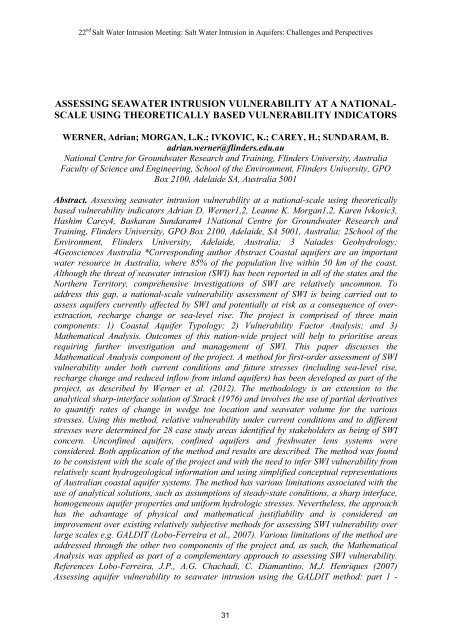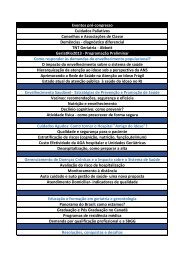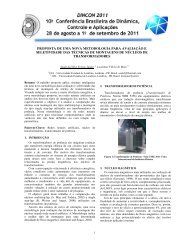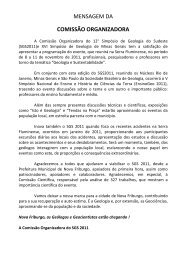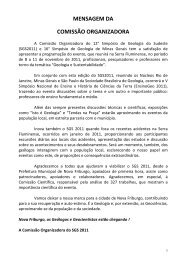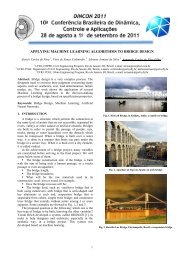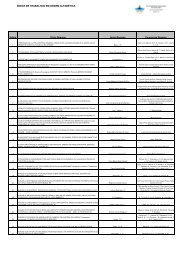Here - Meta Marketing e Eventos
Here - Meta Marketing e Eventos
Here - Meta Marketing e Eventos
- No tags were found...
You also want an ePaper? Increase the reach of your titles
YUMPU automatically turns print PDFs into web optimized ePapers that Google loves.
22 nd Salt Water Intrusion Meeting: Salt Water Intrusion in Aquifers: Challenges and PerspectivesASSESSING SEAWATER INTRUSION VULNERABILITY AT A NATIONAL-SCALE USING THEORETICALLY BASED VULNERABILITY INDICATORSWERNER, Adrian; MORGAN, L.K.; IVKOVIC, K.; CAREY, H.; SUNDARAM, B.adrian.werner@flinders.edu.auNational Centre for Groundwater Research and Training, Flinders University, AustraliaFaculty of Science and Engineering, School of the Environment, Flinders University, GPOBox 2100, Adelaide SA, Australia 5001Abstract. Assessing seawater intrusion vulnerability at a national-scale using theoreticallybased vulnerability indicators Adrian D. Werner1,2, Leanne K. Morgan1,2, Karen Ivkovic3,Hashim Carey4, Baskaran Sundaram4 1National Centre for Groundwater Research andTraining, Flinders University, GPO Box 2100, Adelaide, SA 5001, Australia; 2School of theEnvironment, Flinders University, Adelaide, Australia; 3 Naiades Geohydrology;4Geosciences Australia *Corresponding author Abstract Coastal aquifers are an importantwater resource in Australia, where 85% of the population live within 50 km of the coast.Although the threat of seawater intrusion (SWI) has been reported in all of the states and theNorthern Territory, comprehensive investigations of SWI are relatively uncommon. Toaddress this gap, a national-scale vulnerability assessment of SWI is being carried out toassess aquifers currently affected by SWI and potentially at risk as a consequence of overextraction,recharge change or sea-level rise. The project is comprised of three maincomponents: 1) Coastal Aquifer Typology; 2) Vulnerability Factor Analysis; and 3)Mathematical Analysis. Outcomes of this nation-wide project will help to prioritise areasrequiring further investigation and management of SWI. This paper discusses theMathematical Analysis component of the project. A method for first-order assessment of SWIvulnerability under both current conditions and future stresses (including sea-level rise,recharge change and reduced inflow from inland aquifers) has been developed as part of theproject, as described by Werner et al. (2012). The methodology is an extension to theanalytical sharp-interface solution of Strack (1976) and involves the use of partial derivativesto quantify rates of change in wedge toe location and seawater volume for the variousstresses. Using this method, relative vulnerability under current conditions and to differentstresses were determined for 28 case study areas identified by stakeholders as being of SWIconcern. Unconfined aquifers, confined aquifers and freshwater lens systems wereconsidered. Both application of the method and results are described. The method was foundto be consistent with the scale of the project and with the need to infer SWI vulnerability fromrelatively scant hydrogeological information and using simplified conceptual representationsof Australian coastal aquifer systems. The method has various limitations associated with theuse of analytical solutions, such as assumptions of steady-state conditions, a sharp interface,homogeneous aquifer properties and uniform hydrologic stresses. Nevertheless, the approachhas the advantage of physical and mathematical justifiability and is considered animprovement over existing relatively subjective methods for assessing SWI vulnerability overlarge scales e.g. GALDIT (Lobo-Ferreira et al., 2007). Various limitations of the method areaddressed through the other two components of the project and, as such, the MathematicalAnalysis was applied as part of a complementary approach to assessing SWI vulnerability.References Lobo-Ferreira, J.P., A.G. Chachadi, C. Diamantino, M.J. Henriques (2007)Assessing aquifer vulnerability to seawater intrusion using the GALDIT method: part 1 -31


